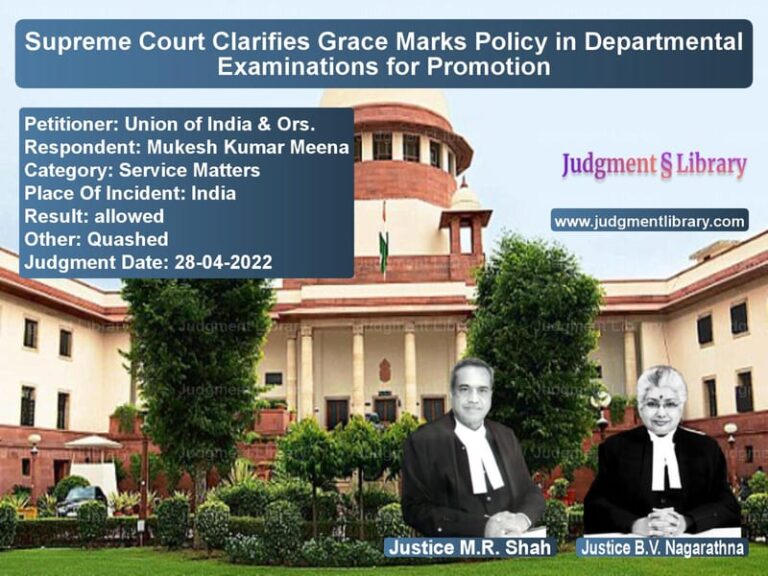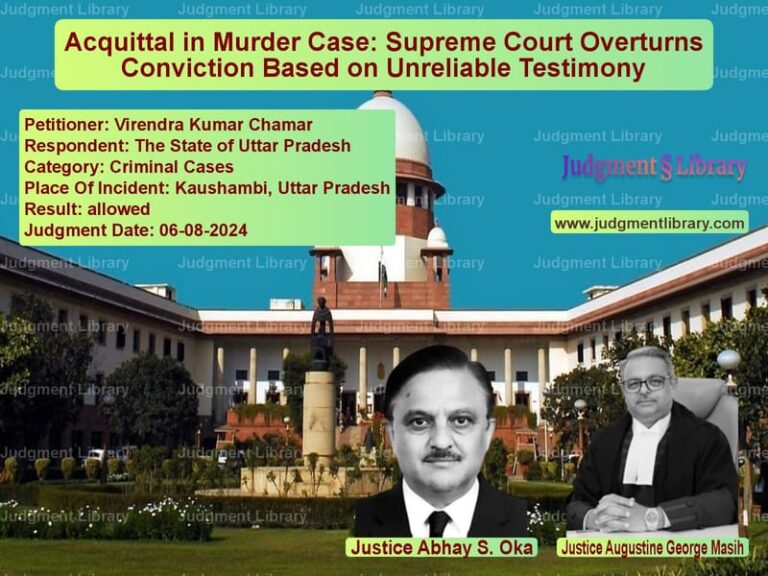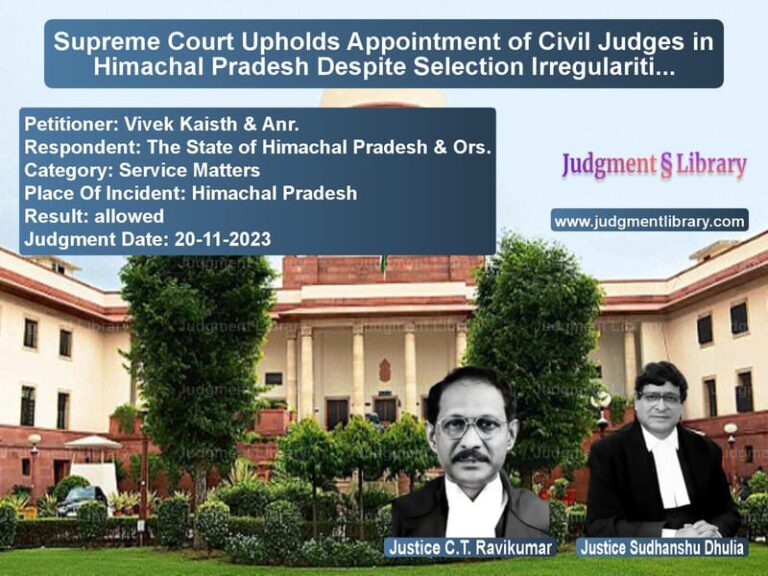Supreme Court Acquits Man After 10 Years in Prison: Circumstantial Evidence Deemed Insufficient
In a landmark ruling, the Supreme Court of India acquitted Hansraj, who had been convicted under Section 302 of the Indian Penal Code (IPC) for the murder of Ramlal in the village of Ghotha Sakulpara, District Kanker, Chhattisgarh. The judgment overturned both the Trial Court and High Court decisions, citing lack of conclusive circumstantial evidence and benefit of doubt to the accused.
Background of the Case
The case revolved around the alleged murder of Ramlal on March 28, 2002. The prosecution claimed that Hansraj, who had been assisting the deceased in his work for over two months, committed the crime due to strained relations over unpaid wages. The conviction was based solely on circumstantial evidence, as there were no eyewitnesses to the incident.
The Trial Court convicted Hansraj and sentenced him to life imprisonment with a fine of Rs. 1,000. The High Court upheld the conviction. Hansraj then appealed to the Supreme Court, where his case was accepted despite a delay of 653 days. He had already served over ten years in prison before being released on bail during the appeal process.
Key Legal Issues
- Whether the circumstantial evidence was sufficient to establish guilt beyond a reasonable doubt.
- The reliability of witness testimonies regarding the accused’s presence at the crime scene.
- Whether motive alone could justify a conviction in the absence of direct evidence.
- The validity of forensic evidence and weapon recovery claims.
Arguments by the Appellant
The appellant’s counsel argued:
- The entire case was fabricated, and the circumstantial evidence was not strong enough to warrant conviction.
- The prosecution’s claim that Hansraj had a motive due to unpaid wages was weak and unsupported by any substantial evidence.
- The “last seen” theory was unreliable, as there was no independent evidence proving Hansraj was with the deceased just before the murder.
- The alleged murder weapon (a farsi) was recovered nearly a month after the incident, making it an unreliable piece of evidence.
- Key prosecution witnesses contradicted each other regarding the accused’s presence and his alleged fleeing from the scene.
“The prosecution has failed to provide an unbroken chain of circumstances that lead only to the guilt of the accused. The possibility of an alternative hypothesis of innocence cannot be ruled out.”
Arguments by the Respondent
The prosecution contended:
- Hansraj was the last person seen with the deceased before his murder, making him the prime suspect.
- His motive, coupled with his alleged attempt to flee, established guilt beyond a reasonable doubt.
- The farsi recovered from the accused matched the type of weapon used to commit the murder.
- Witness testimonies from the victim’s wife and neighbors placed the accused at the crime scene.
“The accused had both motive and opportunity. His flight from the scene immediately after the murder further strengthens the prosecution’s case.”
Supreme Court’s Observations
The Supreme Court examined the evidence and found several inconsistencies:
- The alleged motive (unpaid wages) was weak and lacked corroborating evidence.
- There was no forensic evidence linking the accused to the crime scene or the recovered weapon.
- Key witnesses contradicted themselves regarding the accused’s presence and actions after the crime.
- The accused’s flight from the scene was not proven beyond doubt.
“The prosecution’s case rests entirely on circumstantial evidence, which fails to establish guilt conclusively. The benefit of doubt must go to the accused.”
Final Judgment
The Supreme Court ruled:
“The impugned judgment and orders dated 19.12.2002 and 30.07.2012 are hereby set aside. The appellant is acquitted of all charges and is to be released immediately. His bail bonds and sureties are discharged.”
Hansraj, who had already served over ten years in prison, was declared innocent due to lack of conclusive evidence.
Significance of the Judgment
This ruling has several important implications:
- It reinforces the principle that circumstantial evidence must be strong enough to rule out all possible alternative explanations.
- It upholds the requirement for forensic verification in cases relying on physical evidence.
- It affirms that motive alone is insufficient for conviction without direct evidence.
- It highlights the importance of consistency in witness testimonies.
By acquitting Hansraj, the Supreme Court has reaffirmed the fundamental principle that guilt must be proven beyond a reasonable doubt, ensuring that justice is not compromised due to weak or circumstantial evidence.
Petitioner Name: Hansraj.Respondent Name: State of Chhattisgarh.Judgment By: Justice Pankaj Mithal, Justice Ahsanuddin Amanullah.Place Of Incident: Kanker, Chhattisgarh.Judgment Date: 10-02-2025.
Don’t miss out on the full details! Download the complete judgment in PDF format below and gain valuable insights instantly!
Download Judgment: hansraj-vs-state-of-chhattisgar-supreme-court-of-india-judgment-dated-10-02-2025.pdf
Directly Download Judgment: Directly download this Judgment
See all petitions in Murder Cases
See all petitions in Bail and Anticipatory Bail
See all petitions in Judgment by Pankaj Mithal
See all petitions in Judgment by Ahsanuddin Amanullah
See all petitions in allowed
See all petitions in Quashed
See all petitions in supreme court of India judgments February 2025
See all petitions in 2025 judgments
See all posts in Criminal Cases Category
See all allowed petitions in Criminal Cases Category
See all Dismissed petitions in Criminal Cases Category
See all partially allowed petitions in Criminal Cases Category







